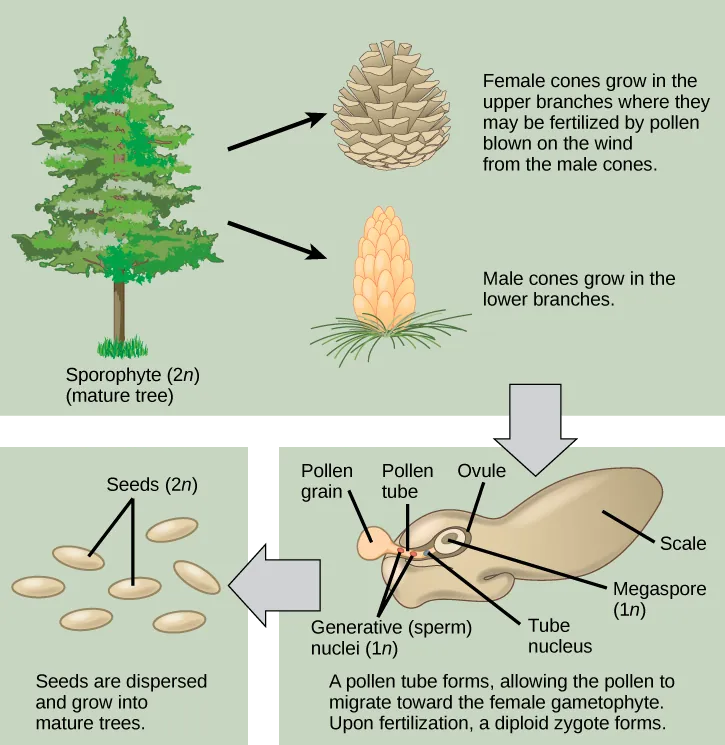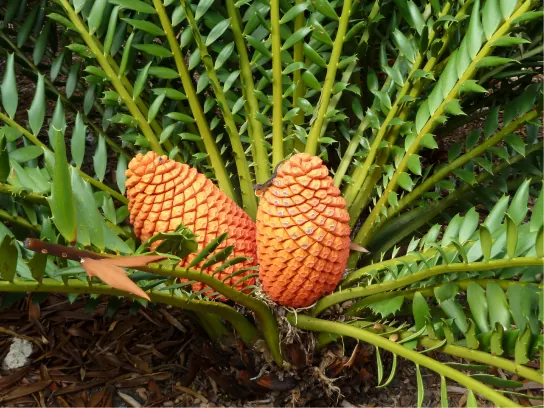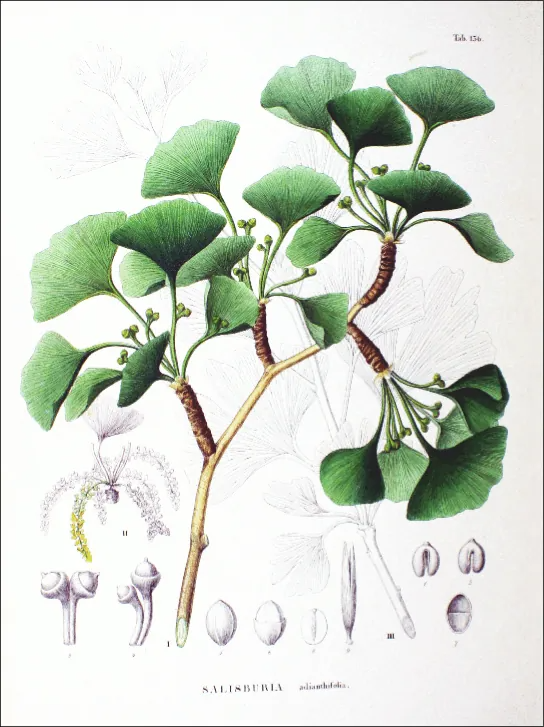26.2 Gymnosperms
Learning Outcomes
- Discuss the type of seeds produced by gymnosperms, as well as other characteristics of gymnosperms
- Identify the conditions to which gymnosperms are adapted
- List the four groups of modern-day gymnosperms and provide examples of each
- Describe the life cycle of a typical gymnosperm
Gymnosperms, meaning “naked seeds,” are a diverse group of seed plants. Characteristics of the gymnosperms include naked seeds, separate female and male gametes, pollination by wind, and tracheids (which transport water and solutes in the vascular system).
Gymnosperm seeds are not enclosed in an ovary; rather, they are only partially sheltered by modified leaves called sporophylls. You may recall the term strobilus (plural = strobili) describes a tight arrangement of sporophylls around a central stalk, as seen in pine cones. Some seeds are enveloped by sporophyte tissues upon maturation. The layer of sporophyte tissue that surrounds the megasporangium, and later, the embryo, is called the integument.
Gymnosperms were the dominant phylum in the Mesozoic era. They are adapted to live where fresh water is scarce during part of the year, or in the nitrogen-poor soil of a bog. Therefore, they are still the prominent phylum in the coniferous biome or taiga, where the evergreen conifers have a selective advantage in cold and dry weather. Evergreen conifers continue low levels of photosynthesis during the cold months, and are ready to take advantage of the first sunny days of spring.
The life cycle of a gymnosperm involves alternation of generations, with a dominant sporophyte in which reduced male and female gametophytes reside. All gymnosperms are heterosporous. The male and female reproductive organs can form in cones or strobili. Male and female sporangia are produced either on the same plant, described as monoecious (“one home” or bisexual), or on separate plants, referred to as dioecious (“two homes” or unisexual) plants. The life cycle of a conifer will serve as our example of reproduction in gymnosperms.
Life Cycle of a Conifer
Pine trees are conifers (coniferous = cone bearing) and carry both male and female sporophylls on the same mature sporophyte. Therefore, they are monoecious plants. Like all gymnosperms, pines are heterosporous and generate two different types of spores (male microspores and female megaspores). Male and female spores develop in different strobili, with small male cones and larger female cones. In the male cones, or staminate cones, the microsporocytes undergo meiosis and the resultant haploid microspores give rise to male gametophytes or “pollen grains” by mitosis. Each pollen grain consists of just a few haploid cells enclosed in a tough wall reinforced with sporopollenin. In the spring, large amounts of yellow pollen are released and carried by the wind. Some gametophytes will land on a female cone. Pollination is defined as the initiation of pollen tube growth. The pollen tube develops slowly, and the generative cell in the pollen grain produces two haploid sperm by mitosis. At fertilization, one of the haploid sperm nuclei will unite with the haploid nucleus of an egg cell.
Female cones, or ovulate cones, contain two ovules per scale. Each ovule has a narrow passage that opens near the base of the sporophyll. This passage is the micropyle, through which a pollen tube will later grow. One megaspore mother cell, or megasporocyte, undergoes meiosis in each ovule. Three of the four cells break down; only a single surviving cell will develop into a female multicellular gametophyte, which encloses archegonia (an archegonium is a reproductive organ that contains a single large egg). As the female gametophyte begins to develop, a sticky pollination drop traps windblown pollen grains near the opening of the micropyle. A pollen tube is formed and grows toward the developing gametophyte. One of the generative or sperm nuclei from the pollen tube will enter the egg and fuse with the egg nucleus as the egg matures. Upon fertilization, the diploid egg will give rise to the embryo, which is enclosed in a seed coat of tissue from the parent plant. Although several eggs may be formed and even fertilized, there is usually a single surviving embryo in each ovule. Fertilization and seed development is a long process in pine trees: it may take up to two years after pollination. The seed that is formed contains three generations of tissues: the seed coat that originates from the sporophyte tissue, the gametophyte tissue that will provide nutrients, and the embryo itself.
Figure 26.8 illustrates the life cycle of a conifer. The sporophyte (2n) phase is the longest phase in the life of a gymnosperm. The gametophytes (1n)—produced by microspores and megaspores—are reduced in size. It may take more than a year between pollination and fertilization while the pollen tube grows towards the growing female gametophyte (1n), which develops from a single megaspore. The slow growth of the pollen tube allows the female gametophyte time to produce eggs (1n).
Visual Connection
Conifer Life Cycle

Diversity of Gymnosperms
Modern gymnosperms are classified into four phyla. Coniferophyta, Cycadophyta, and Ginkgophyta are similar in their pattern of seed development and also in their production of secondary cambium (cells that generate the vascular system of the trunk or stem and are partially specialized for water transportation). However, the three phyla are not closely related phylogenetically to each other. Gnetophyta are considered the closest group to angiosperms because they produce true xylem tissue, with vessels as well as the tracheids found in the rest of the gymnosperms.
Conifers (Coniferophyta)
Conifers are the dominant phylum of gymnosperms, with the greatest variety of species (Figure 26.9). Typical conifers are tall trees that bear scale-like or needle-like leaves. Water evaporation from leaves is reduced by their narrow shape and a thick cuticle. Snow easily slides off needle-shaped leaves, keeping the snow load light, thus reducing broken branches. Such adaptations to cold and dry weather explain the predominance of conifers at high altitudes and in cold climates. Conifers include familiar evergreen trees such as pines, spruces, firs, cedars, sequoias, and yews. A few species are deciduous and lose their leaves in fall. The bald cypress and the tamarack (Figure 26.9c) are examples of deciduous conifers. The wood of conifers is more primitive than the wood of angiosperms; it contains tracheids, but no vessel elements, and is therefore referred to as “soft wood.”

Cycads
Cycads thrive in mild climates, and are often mistaken for palms because of the shape of their large, compound leaves. Cycads bear large strobili or cones (Figure 26.10), and may be pollinated by beetles rather than wind, which is unusual for a gymnosperm. Large cycads dominated the landscape during the age of dinosaurs. They face possible extinction, and several species are protected through international conventions. Because of their attractive shape, they are often used as ornamental plants in gardens in the tropics and subtropics.

Ginkgophytes
The single surviving species of the ginkgophytes group is Ginkgo biloba (Figure 26.11). Its fan-shaped leaves—unique among seed plants because they feature a dichotomous venation pattern—turn yellow in autumn and fall from the tree. Male and female organs are produced on separate plants.

Gnetophytes
The phylogenetic position of the gnetophytes is not currently resolved. Their possession of vessel elements suggests they are the closest relative to modern angiosperms. However, molecular analysis places them closer to the conifers. The three living genera are quite dissimilar: Ephedra, Gnetum, and Welwitschia (Figure 26.12), which may indicate that the group is not monophyletic. Like angiosperms, they have broad leaves. Ephedra (Figure 26.12a) occurs in dry areas of the West Coast of the United States and Mexico. Gnetum species (Figure 26.12.b) are found in some parts of Africa, South America, and Southeast Asia, and include trees, shrubs and vines. Welwitschia (Figure 26.12c) is found in the Namib desert,


